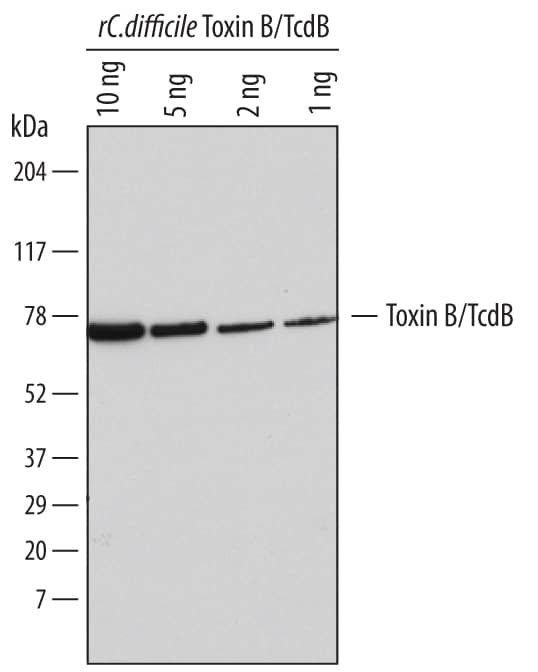C. difficile Toxin B/TcdB Antibody
R&D Systems, part of Bio-Techne | Catalog # AF6246

Key Product Details
Species Reactivity
Validated:
Cited:
Applications
Validated:
Cited:
Label
Antibody Source
Product Specifications
Immunogen
Ser2-Leu543
Accession # P18177
Specificity
Clonality
Host
Isotype
Scientific Data Images for C. difficile Toxin B/TcdB Antibody
Detection ofC. difficileToxin B/TcdB by Western Blot.
Western blot shows recombinantC. difficileToxin B/TcdB (Catalog # 6246-GT). PVDF membrane was probed with 1 µg/mL of Sheep Anti-C. difficileToxin B/TcdB Antigen Affinity-purified Polyclonal Antibody (Catalog # AF6246) followed by HRP-conjugated Anti-Sheep IgG Secondary Antibody (Catalog # HAF016). A specific band was detected for Toxin B/TcdB at approximately 75 kDa (as indicated). This experiment was conducted under reducing conditions and using Immunoblot Buffer Group 1.Applications for C. difficile Toxin B/TcdB Antibody
Western Blot
Sample: Recombinant C. difficile Toxin B/TcdB (Catalog # 6246-GT)
Formulation, Preparation, and Storage
Purification
Reconstitution
Formulation
Shipping
Stability & Storage
- 12 months from date of receipt, -20 to -70 °C as supplied.
- 1 month, 2 to 8 °C under sterile conditions after reconstitution.
- 6 months, -20 to -70 °C under sterile conditions after reconstitution.
Background: Toxin B/TcdB
Clostridium difficile is the leading cause of hospital-acquired diarrhea, known as C. difficile-associated disease. The estimated number of cases of C. difficile-associated disease exceeds 250,000 per year (1), with health care costs approaching US $1 billion annually (2). The major virulence factors produced by C. difficile are two toxins, TcdA and TcdB. Both toxins can monoglucosylate and inactivate Rho family small GTPases within target cells, leading to disruption of vital signaling pathways in the cell, subsequently causing diarrhea, inflammation, and damage of colonic mucosa (3, 4, 5). Both toxins have a similar tripartite structure comprised of an N‑terminal glucosyltransferase domain, a C-terminal receptor binding domain, and a small hydrophobic span possibly involved in toxin translocation (6). Our recombinant TcdB consists of the enzymatic domain. Both TcdA and TcdB also have potassium-dependent UDP-Glc hydrolase activity, which is essentially glucosyltransferase activity with water as the acceptor molecule (7). Under same conditions, UDP-glucose hydrolysis by TcdB occurs at a rate about 5-fold greater than that of TcdA.
References
- Wilkins, T.D. and Lyerly, D.M. (2003) J. Clin. Microbiol 41:53.
- Kyne, L. et al. (2002) Clin. Infect. Dis. 34:346.
- Voth, D.E. and Ballard, J.D. (2005) Clin. Microbiol. Rev. 18:247.
- Chaves-Olarte, E. et al. (1996) J. Biol. Chem. 271:6925.
- Just I, et al. (1995) J. Biol. Chem. 270:13932.
- Hammond, G.A. and Johnson, J.L. (1995) Microb. Pathog. 19:203.
- Ciesla, W.P. Jr. and Bobak, D.A. (1998) J. Biol. Chem. 273:16021.
Alternate Names
Entrez Gene IDs
Gene Symbol
UniProt
Additional Toxin B/TcdB Products
Product Documents for C. difficile Toxin B/TcdB Antibody
Product Specific Notices for C. difficile Toxin B/TcdB Antibody
For research use only
